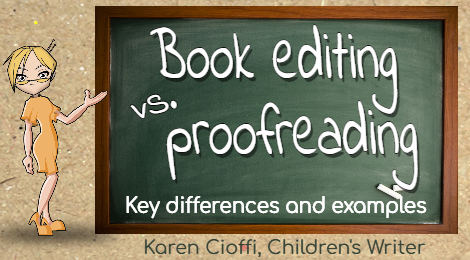When preparing a book for publication, whether submitting it to publishers or agents or self-publishing, both editing and proofreading are crucial steps in the process. However, they serve distinct purposes and involve different skill sets.
Understanding the differences between editing and proofreading can help writers decide which process their manuscript needs before sending it out into the world.
This article delves into these differences, provides examples, and explains when to use each service.
WHAT IS BOOK EDITING?
Book editing is a broad term that includes various stages of revision aimed at improving a manuscript's clarity, readability, coherence, and overall quality. Editing is an intensive process that helps ensure a book is engaging, logically structured, and polished in terms of both content and style.
There are several types of book editing:
Developmental Editing: This is the most comprehensive form of editing. It focuses on the big picture: the book’s structure, plot, character development, themes, and overall flow. A developmental editor might suggest reordering chapters, refining character arcs, or expanding certain sections for better clarity.
This form of editing is sometimes referred to as substantive editing, but that wasn’t always the case.
Example: A writer’s manuscript has the protagonist undergoing an unrealistic transformation within a single chapter. A developmental editor might recommend adding scenes to gradually show this change rather than presenting it abruptly.
Line Editing: This process focuses on improving sentence structure, word choice, and writing style to ensure movement and readability. Line editors refine prose by eliminating redundancy, enhancing tone, and making language understandable and more compelling.
Example: A manuscript has too many repetitive or redundant phrases like “she whispered softly” or “he ran quickly.” A line editor would revise these to “she whispered” or “he dashed” to create more effective prose.
Copy Editing: Copy editing is more technical, addressing grammar, punctuation, spelling, and consistency in terminology, style, and formatting. It ensures adherence to a particular style guide (e.g., The Chicago Manual of Style for books).
Example: If a manuscript inconsistently uses both “gray” and “grey,” a copy editor will standardize the spelling according to the chosen style guide.
WHAT IS PROOFREADING?
Proofreading is the final step in the editing process and focuses purely on surface-level errors. It occurs after all major editing phases are complete, ensuring the text is free from typographical, grammatical, and formatting mistakes. Unlike editing, proofreading does not involve changing content, restructuring sentences, or improving clarity; it strictly aims to catch any overlooked errors.
Example: A proofreader might spot a misplaced comma, a misspelled word, or a missing period in an otherwise polished manuscript. If a sentence reads, “She went to the store, and bought bananas,” a proofreader would correct it to, “She went to the store and bought bananas.”
KEY DIFFERENCES BETWEEN EDITING AND PROOFREADING
Editing
Purpose: Improves content, style, logic, and structure
Focus: Sentence structure, tone, logic, and flow
Depth: In-depth, may involve rewriting
Timing: Done in early to mid-stages of revision
Examples: Reconstructing paragraphs, checking for clarity, refining dialogue
Proofreading
Purpose: Corrects spelling, grammar, and punctuation
Focus: Typos, formatting, and minor errors
Depth: Surface-level corrections
Timing: Final stage, before publication
Examples: Fixing misspelled words, checking punctuation
WHEN TO USE EDITING VS. PROOFREADING
Use Editing When:
You need help refining your story.
Your manuscript has issues with clarity, coherence, or consistency.
You want feedback on character development, pacing, or theme effectiveness.
You’re open to reworking sentences or restructuring sections.
Use Proofreading When:
Your book has already gone through the editing process.
You need a final quality check before publication.
You want to ensure there are no typographical or grammatical errors.
You’re confident in the book’s content and structure but need a last once over.
SUMMING IT UP
Both editing and proofreading are essential for producing a professional, high-quality book. While editing focuses on refining content, style, and structure, proofreading serves as the last quality control check to ensure the manuscript is error-free.
Writers should consider their manuscript’s needs and timeline to determine which editing process they need and whether they require a final proofreading. If using a professional editor or proofreader, there will be a monetary cost, but it can significantly enhance your book’s readability and impact, help get the manuscript past the gatekeeper and provide a polished book for your readers.
I hope this helps in your editing process.

Young Children’s Books: The Power of Repetition
What is Subtext and How to Use It Effectively in Your Writing
How Do I Sell My Books?

I’m a working children’s ghostwriter, rewriter, editor, and coach. I can help turn your story into a book you’ll be proud to be the author of, one that’s publishable and marketable.
OTHER HELP I OFFER:
HOW TO WRITE A CHILDREN’S FICTION BOOK
A DIY book to help you write your own children’s book.
PICTURE BOOK, CHAPTER BOOK, MIDDLE GRADE COACHING
Four to twelve-week coaching programs.
FICTION WRITING FOR CHILDREN eCOURSE
4-Weeks / 8 Sections Guided Self-Study Mentoring Program
You can contact me at: kcioffiventrice@gmail.com. Or give me a call at 347—834—6700. (Please leave a message- I’ll get back to you as soon as I can.)


2 thoughts on “Book Editing vs. Proofreading: Understanding the Key Differences”